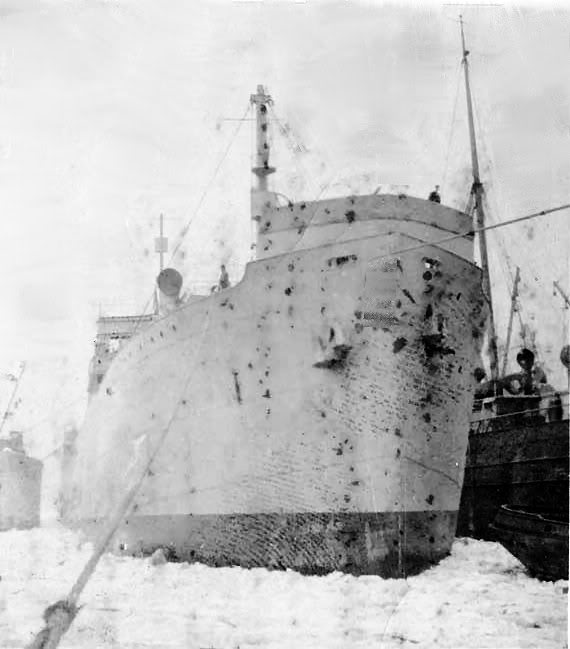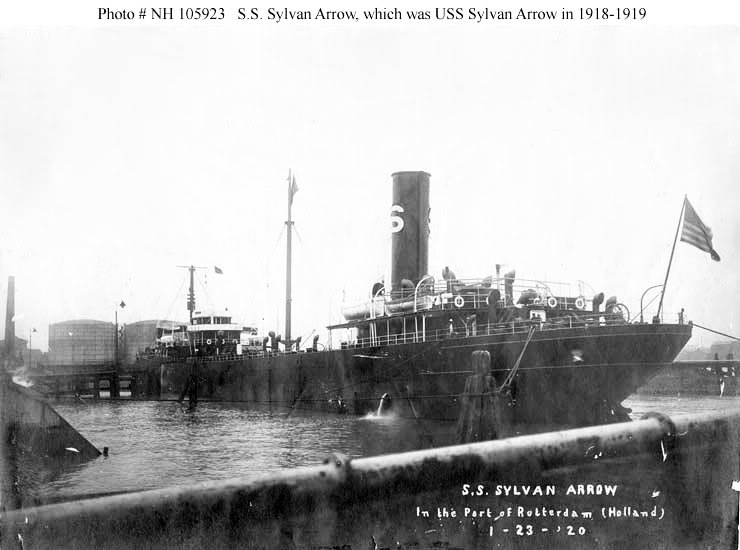Auke Visser's MOBIL Tankers & Tugs Site | home
Sylvan Arrow (1) - (1919-1942)
See also : On Board Photos "Sylvan Arrow (1)" & German Records off the Attack on the SS "Sylvan Arrow (1)"
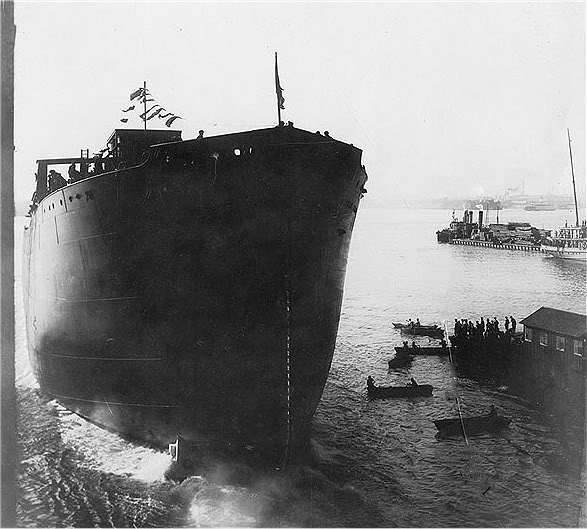
"Sylvan Arrow" during her launch at the New York Shipbuilding Co. shipyard, Camden, New Jersey.
"Sylvan Arrow" was built in 1918 by New York Shipbuilding, Camden, NJ., yard no. 174.
Keel laid on Mar 22, 1917, launched Oct 16, 1917.
Oil tanker (Standard Oil).
Torpedoed and sunk by U-155 southwest of Grenada, May 20, 1942.
( U.S. Naval Historical Center Photograph )
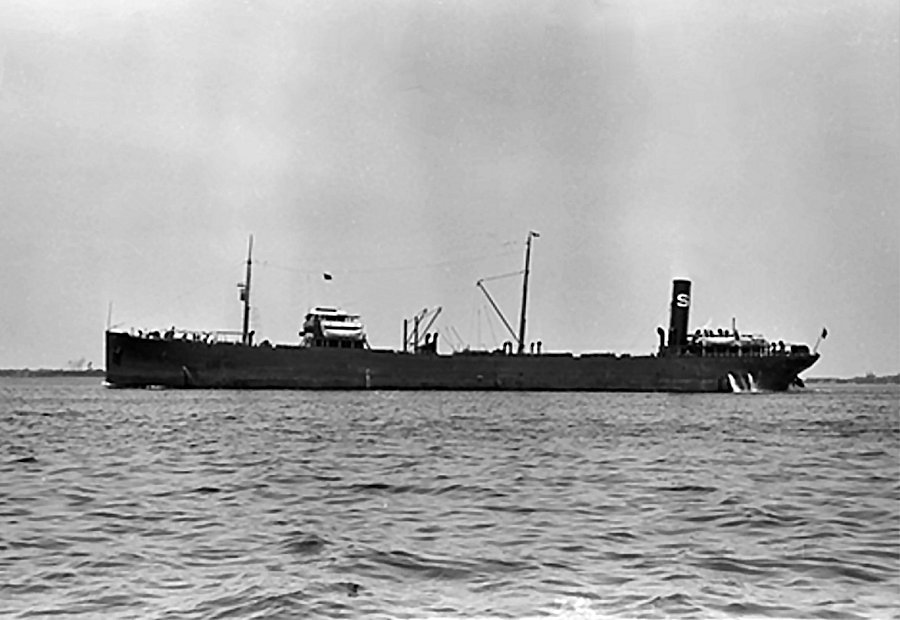
( Photo Taylor, William B. )
Sylvan Arrow
LOA 485'2", Beam 62'6", Depth 39'6", 13,395 DWT, 99,742 bbls
Quadruple expansion engine 51" stroke 3200 HP,10.6 knots
Launched 16 October 1917 and commissioned 5 January 1918 at New York Shipbuilding Corporation, Camden, New Jersey.
Commissioned during WWI, SYLVAN ARROW was pressed immediately into overseas support of the Allies, making three transatlantic voyages With War cargoes before being taken over by the US Navy in July 1918. She served throughout the War delivering fuel oil to our military and naval bases in France. She was so useful to the Navy that she was not returned to Socony-
Vacuum until January 1919, at which time she at last entered the Far East trade for Which she had been built.
SYLVAN ARROW put in 11 years on the long hauls across the Pacific and was not withdrawn for the short US east coast hauls until 1930. She continued in the domestic groove until August 1940, When, with ROYAL ARROW, she was transferred by inter-company sale to our marine subsidiary Brilliant Transportation Company, running under the Panamanian flag.
In April 1942, she was requisitioned for WWII by WSA at Norfolk, Virginia. On 20 May 1942, while in convoy out of Curacao for Cape Town, South Africa, SYLVAN ARROW Was torpedoed. She caught fire and was abandoned. Six days later, after an unsuccessful attempt had been made to salvage her, SYLVAN ARROW sank by the head, about 75 miles from Trinidad.
|
SS SYLVAN ARROW
Home Port: Panama City, R.P.
Company: Socony Vacuum Oil Co.
Master: Arthur J. Beck
Built: Camden, NJ 1917
Gross Tons: 7797
Dimensions: 485' x 62' x 39'
Capacity: 99,742 barrels
The Panamanian flag tanker, SS SYLVAN ARROW, was torpedoed by the German U-155 (Adolph Piening) on May 20, 1942 at 0721 ship's time while en route from Curacao to Cape Town, South Africa with a full cargo of Bunker C oil, in Convoy OT-1 in position 11-22 N./62-14 W. This vessel left Curacao on May l8th in convoy with the British tank-er BETHANCURIA and the Norwegian freighter RAPANA escorted by HMS HAVELOCK (H-88) and HMS LAVEN-DER (K-60).
The ship's complement was made up of 38 crew members and 6 U.S. Naval Armed Guard. One Navy gunner was lost.
The explosion of the torpedo blew fuel oil all over the tanker.In addition, the main deck was blown upward and out-ward. The entire midship section of the ship abaft the bridge was aflame with thick smoke. The ship continued speeding full ahead.
Boats #2 and #4 were launched. Boat #2 was safely launched even though burning fuel oil had set the falls on fire. This boat, in charge of the Chief Mate, rowed around the port bow to take off 22 men who were trapped on the bow by the flames. Boat #4 was safely launched with 12 men aboard in charge of the Chief Engineer. The forward star-board boat (#1) was destroyed by fire.
The entire Naval Armed Guard remained aboard ship to right the sub in case it surfaced but later were forced to aban don ship. They tried to launch #3 boat but could not so they were forced to jump overboard. They were later picked up by the USS BARNEY (DD-149) and not a moment too soon as they were coated with oil and exhausted. The other two boats were picked up by the BARNEY also. All were taken to Port of Spain, Trinidad.
The merchant crew became separated in two groups. The 26 men In #2 boat which was in charge of the Chief Mate, were at Port of Spain awaiting repatriation. The remaining 12 crew members including the Master were engaged in at tempting to salvage the help. The 26 men In Port of Spain were repatriated aboard the SS ROBERT E. LEE, ar-riving in New Orleans safely.
After 3 days of searching for the damaged ship, towing procedures were put into effect on May 26th. When the sal-vage tug began to tow the ship she began to rip apart and break up. The towing attempt was abandoned. The SYL-VAN ARROW settled deeper into the sea, folding in the middle and sinking about 1700 on May 28th in position 12-50 N./67-32 W.
Captain Beck and his 11 men were taken to Curacao where they were cut off from the main body of the crew which was in Port of Spain. They left Curacao aboard the Dutch freighter, SS CRIJNSSEN on June 7, 1942. On June 10th, the CRIJNSSEN was torpedoed. Captain Beck and 6 of his fellow crew members of the SYLVAN ARROW found themselves in a lifeboat holding 31 persons including themselves. He assumed command of the boat and set a course for the Yucatan coast of Mexico. Eventually the boat reached the Mexican coast after being passed by sever-al ships. Captain Beck and his 6 crew members were finally repatriated from Chetumal, Mexico by air to Browns-ville, Texas and by train from there to New York.
The remaining 5 crew members of the SYLVAN ARROW were in another lifeboat from the CRIJNSSEN. They were picked up by the SS LEBORE carrying a full load of coal to Chile. On June 14th this ship was also torpedoed and they had to take to the boats again. This time they were in a crowded boat for 3 days before being picked up by the USS TATTNALL (DD 125) and landed at Cristobal. The boats were first sighted by a Patrol plane.
The U-155 (Altmeier) surrendered at Wilhelmshaven on June 10, 1945.
U.S. NAVAL ARMED GUARD LOST
WEATHERFORD, Charles - USNR - (Fell overboard from oil slicked gun platform and drowned.)
|
SS Sylvan Arrow, photographed circa early 1918. This tanker, completed in January 1918,
was in commission as USS Sylvan Arrow from 19 July 1918 to 21 January 1919.
( U.S. Naval Historical Center Photograph )
SS Sylvan Arrow,possibly photographed when the ship was inspected by the Third Naval
District in January 1918. This tanker served as USS Sylvan Arrow from July 1918 to January 1919.
Note the ice surrounding the ship and the probable gun position on the bow.
( U.S. Naval Historical Center Photograph )
Sylvan Arrow, a 7797 gross ton tanker, was built at Camden, New Jersey, in 1917. She was taken over by the Navy and commis-
sioned in July 1918 as USS Sylvan Arrow (ID # 2150). As a unit of the Naval Overseas Transportation Service, she made two vo-
yages to England, carrying fuel oil and deck cargo, before the Armistice ended World War I combat in November. In January 1919,
a little over a month after returning to the U.S. at the end of her second trans-Atlantic round-trip, USS Sylvan Arrow was de-
commissioned and returned to her owner.
Information from Starke & Schell Ships-registers;
SYLVAN ARROW - 1918 USA , 1Q (aft), (11)
7,797 GRT for Standard Transportation Co., Inc., New York 467.6 x 62.7
Tanker build by New York SB. Corp., Camden, N.J.,, (1), #174, 215840
(7/18 - 1/19 U. S. Navy requisition - Naval Overseas Transportation Service #2150)
1931 - Standard-Vacuum Transportation Co., Inc., New York
1935 - Socony-Vacuum Oil Co., Inc., New York
1941 - Brilliant Transportation Co., S.A., Panama [Socony-Vacuum Oil Co.], PA
Torp. by U 155, 20 May 1942, in 11.25N-62.18W, voyage Curaçao - Table Bay, fuel oil,
sank 28 May in 12.50 N - 67.40 W.
Name: Sylvan Arrow
Type: Steam tanker
Tonnage: 7.797 tons
Completed: 1918 - New York Shipbuilding Corp, Camden NJ
Owner: Socony-Vacuum Oil Co Inc, New York Homeport: Panama
Date of attack: 20 May, 1942
Nationality: Panaman Fate: Sunk by U-155 (Adolf Cornelius Piening)
Position: 11.25N, 62.18W - Grid ED 9817
- See location on a map -
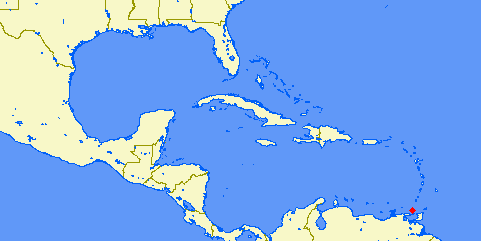
Complement: 44 (1 dead and 43 survivors).
Convoy: OT-1
Route: Curaçao (18 May) - Capetown
Cargo: 125.000 tons of Bunker C oil
History: In 1941, the American Sylvan Arrow was registered in Panama.
Notes on loss:
At 13.21 hours on 20 May, 1942, U-155 fired a spread of two stern torpedoes at two tankers in convoy OT-1 and hit the
Sylvan Arrow (Master Arthur J. Beck) with one of them. The explosion blew oil all over the ship, buckled the main deck and set the
midship section in flames. Some of the 38 crew members managed to launch two lifeboats and took off the remaining men from the
bow where they had been trapped by the fire. The six armed guards manned the gun, but were later forced to jump overboard and one
man drowned. All survivors were picked up by USS Barney (DD 149) and taken to Port of Spain, Trinidad. While 26 crew members
were repatriated to New Orleans aboard the Robert E. Lee, the master and 11 crew members were engaged in a salvage attempt of
their ship. They arrived at the wreck of Sylvan Arrow after three days and on 26 May she was taken in tow by a tug, but began to
break up and finally sank on 28 May in 12°50N/67°32W. The burning and floating tanker had been spotted by U-155 at 15.00 hours
on 21 May, but escorts and aircraft prevented a coup de grâce.
The master and 11 crew members were taken to Curaçao and boarded the Crijnssen, which was sunk by U-504 on 11 June. The
master and six men were in a lifeboat that landed on the Yucatan coast and were later flown from Chetumal to Brownsville, Texas. 5
men were picked up the same day by the Lebore, which was herself sunk by U-172 (Emmermann) on 14 June. They were in a lifeboat
for three days and picked up by USS Tattnall (DD 125) and landed at Cristobal.

